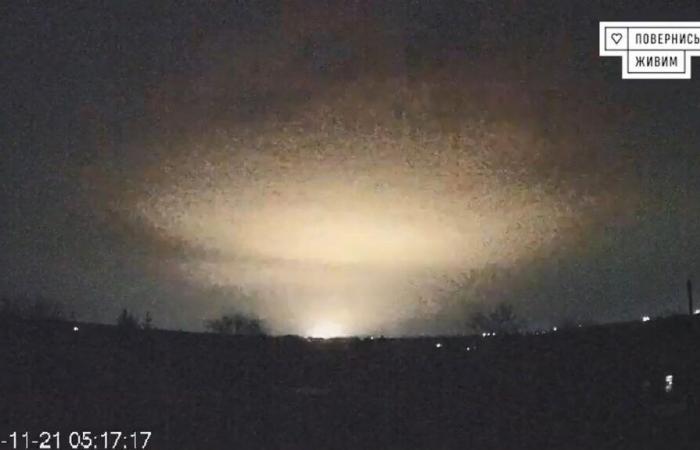
One more weapon in Russia's arsenal. Vladimir Putin claimed responsibility, Thursday, November 21, for the shooting of a “new medium range missile” against a Ukrainian arms factory. A hitherto unknown model, described as“experimental”but which he asked on Friday to launch the “mass production”. This test is presented by Moscow as a response to Ukraine's firing of long-range Western missiles against Russian territory, just authorized by the United States. If certain of its characteristics and its exact range remain unclear, this new model could carry several nuclear warheads and not just one, Ukrainian intelligence estimates. Franceinfo summarizes what we know about this experimental missile.
A missile undoubtedly developed from old models
The Russian president named this missile Orechnik (hazel tree in Russian) and described it, Thursday, as a “intermediate range ballistic missile”used “in its non-nuclear hypersonic configuration”. However, it is not so new, said a spokesperson for the American Department of Defense, Sabrina Singh, according to which he is “based on the Russian model of the RS-26 Rubezh intercontinental ballistic missile”whose Development had been stopped in 2018, according to the Russian state agency Tass.
Fabian Hoffmann, researcher specializing in missiles and nuclear power at the University of Oslo (Norway)supported this hypothesis on X: “I would be surprised if Russia designed such a missile without relying 90% on existing models, or by reusing parts from the RS-26 or another missile”he writes. “This is the first time we have seen it used on the battlefield, so we consider it experimental.”added Sabrina Singh.
On Friday, Vladimir Putin ordered “start mass production” of this new missile and affirmed that the Russian army would continue the tests, during a meeting with military officials broadcast on television. He assured that Russia had a “reserve” of these missiles, “ready to use”and that “no one else in the world” did not currently have this type of weaponry.
A projectile suspected of being able to carry several nuclear charges
Unlike other Russian projectiles already used against Ukraine such as the Iskander and Kh-101, which can only carry a single nuclear warhead, this latest missile would be capable of carrying several, Tom Karako argued , director of the missile defense project at the Center for Strategic and International Studies in Washington, with the New York Times. A particularity which would make these warheads almost impossible to intercept, explains the American daily.
Ukrainian intelligence, cited by AFP, estimates that the missile fired Thursday “was equipped with six warheads, each with six submunitions”based on a video broadcast on social networks showing six powerful successive flashes falling from the sky at the time of the attack.
According to Vladimir Putin, the Orechnik missile fired Thursday can reach the speed of Mach 10, ten times the speed of sound, “i.e. 2.5 to 3 kilometers per second” (environ 12 350 km/h). “Today there is no way to counter such weapons”he estimated. According to Ukrainian intelligence, it even reached “on the final part of the trajectory” a speed “greater than 11 Mach” (environ 13 600 km/h).
A scope still uncertain
Contrary to initial claims by the Ukrainian Air Force that Russia had fired a long-range intercontinental ballistic missile, the Pentagon described the projectile as “intermediate range ballistic missile”as did Vladimir Putin.
The distance between the Russian region of Astrakhan, where the missile was fired from on Thursday according to kyiv, and the satellite manufacturing plant it hit in Dnipro, in central Ukraine, is about 1,000 km. LIntermediate-range missiles have a range of 3,000 to 5,500 km, while an intercontinental projectile can go beyond this limit. An intermediate-range missile, depending on where in Russian territory it is fired from, could theoretically reach almost all of Europe and targets on the west side of the United States, notes Pavel Podvig, a researcher at the United Nations Institute for Disarmament Research in Geneva, in an interview with the Russian media Ostorozhno Novosti.
A response to the shots authorized by the United States against Russia
This shooting is part of a period of tensions depuis on November 17, the date on which the United States authorized theUkraine to use long-range missiles against Russian territory. LThe Ukrainian army has already fired American ATACMS and British Storm Shadow missiles on targets in Russia. Moscow had promised a “appropriate response“.
In his televised speech on Thursday, Vladimir Putin presented the launch of the Oreshnik as a response to two Ukrainian shots. “The regional conflict in Ukraine, previously provoked by the West, has acquired global characteristics“he argued, affirming that he did not rule out striking countries whose weapons are used by Ukraine in Russia.
Vladimir Putin also announced that Russia was working on developing short- and medium-range nuclear missiles to counter US plans to produce and deploy similar missiles in Europe and Asia. “I consider that the United States made a mistake by unilaterally breaking the Treaty on the Elimination of Intermediate and Short-Range Missiles in 2019, under a far-fetched pretext”he declared. The United States withdrew from this agreement in 2019under Donald Trump's first term, accusing Russia of not respecting him.
Ukrainian President Volodymyr Zelensky denounced on “further proof that Russia definitely does not want peace”insisting that Vladimir Putin is solely responsible for this conflict which has lasted for more than a thousand days. On Friday, he requested new air defense systems from his allies, “the kind of systems that can protect lives in the face of new risks”.
Uncertain consequences for the continuation of the conflict
Likely targeting the Pivdenmash factory, a historic Cold War-era missile production site, the missile fired by Russia only caused two injuries and minor damageaccording to the Ukrainian authorities.
For Héloïse Fayet, expert in nuclear deterrence atFrench Institute of International Relations, the use of this projectile “won't make a significant difference operationally. They obviously have very little and they're expensive” the researcher told AFP. This analysis is consistent with that of the United States National Security Council, according to the BBCwho believes that these weapons will not disrupt the course of the conflict.
However, Timothy Wright, of the International Institute for Strategic Studies, emphasizes to the Guardian that this development could influence the strategies of NATO countries, particularly in terms of the acquisition of air defense systems and offensive weapons.





